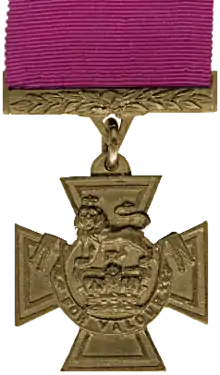Richard Harte Keatinge
Lieutenant General Richard Harte Keatinge VC CSI (17 June 1825 – 25 May 1904) was an Irish recipient of the Victoria Cross, the highest and most prestigious award for gallantry in the face of the enemy that can be awarded to British and Commonwealth forces.
Richard Keatinge | |
|---|---|
 | |
| Born | 17 June 1825 Dublin, Ireland |
| Died | 25 May 1904 (aged 78) Horsham, Sussex |
| Buried | Hills Street Cemetery, Horsham |
| Allegiance | |
| Service/ | |
| Rank | Lieutenant General |
| Unit | |
| Battles/wars | Indian Mutiny |
| Awards | |
| Other work |
|
Life and career
Keatinge was born in Dublin. He was 32 years old, and a major in the Bombay Artillery, Bombay Army during the Indian Mutiny when the following deed took place on 17 March 1858 at the assault of Chundairee for which he was awarded the VC:[1]
Bombay Artillery (now of the Staff Corps)
Major Richard Harte Keatinge Date of Act of Bravery, March 17th, 1858
For having rendered most efficient aid at the assault of Chundairee; in voluntarily leading the Column through the breach, which was protected by a heavy cross fire. He was one of the foremost to enter, and was severely wounded in the breach. The Column was saved from a serious loss that would probably have resulted, but for Major Keatinge's knowledge of the small path leading across the ditch, which had been examined during the night by himself and a servant, who declined, when required, to lead the column, without his master. Having cleared the breach; he led into the Fort where he was struck down by another dangerous wound. The Commander-in-Chief in India states that the success at Chundairee was mainly owing to this Officer, whose gallantry, really brilliant, he considers was equalled by his ability and devotion.
Major Keatinge was at the time a Political Officer with the 2nd Brigade of the Central India Field Force.[2]
In 1862 he was transferred to the Royal Artillery and then to the Bombay Staff Corps of the British Indian Army.
In 1868, Colonel Keatinge designed Rajkumar College, Rajkot, which was formally opened in 1870. The college was founded for the education of the princely order by the princes and chiefs of Kathiawad for their sons and relations.
From 1871 to 1873 he was Chief Commissioner of Ajmer-Merwara.
He became the first Chief Commissioner of Assam[3] in 1874, remaining in this position until 1878.
He later achieved the rank of lieutenant general.
In retirement, he settled at Horsham, Sussex, where he died in 1904.
Legacy
A road in the Indian city of Shillong, which was the capital of the British Province of Assam, where Keatinge had served as Chief Commissioner, has been named Keatinge Road in his honour.
References
- Wilkins, Philip A. (2007). The History of the Victoria Cross: Being an account of the 520 acts of bravery for which the decoration has been awarded and portraits of 392 recipients. The Naval and Military Press Limited. ISBN 9781781516737.
- "No. 22601". The London Gazette. 25 February 1862. p. 956.
- Hussain (Prof.), Imdad (2005). From Residency to Raj Bhavan: A History of the Shillong Government House. Regency Publications. pp. 44–45. ISBN 9788189233273.
Listed in order of publication year
- The Register of the Victoria Cross (1981, 1988 and 1997)
- Clarke, Brian D. H. (1986). "A register of awards to Irish-born officers and men". The Irish Sword. XVI (64): 185–287.
- Ireland's VCs ISBN 1-899243-00-3 (Dept of Economic Development, 1995)
- Monuments to Courage (David Harvey, 1999)
- Irish Winners of the Victoria Cross (Richard Doherty & David Truesdale, 2000)
External links
- Location of grave and VC medal (West Sussex)
| Government offices | ||
|---|---|---|
| New title | Chief Commissioner of Ajmer-Merwara 1871–1873 |
Succeeded by Sir Lewis Pelly |
| Preceded by Henry Hopkinson as Commissioner of Assam |
Chief Commissioner of Assam 1874–1878 |
Succeeded by Stewart Colvin Bayley |